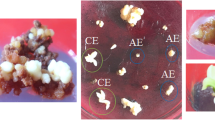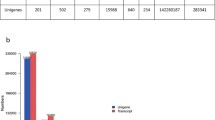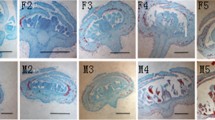Abstract
Studying the genetic mechanism of 2n gametogenesis is of great significance for understanding and utilizing 2n gametes. We previously found that the rubber clone GT1 could spontaneously and steadily produce second division restitution (SDR) 2n female gametes, indicating that the occurrence of 2n female gametes resulted from gene mutation. Furthermore, low temperature during flower development increased the frequency of 2n female gametes. To identify the genes and reveal the molecular mechanism of SDR-type unreduced female gamete formation in diploid rubber tree, six genes related to SDR 2n gametogenesis were identified by comparing the transcriptomes of female flowers with a high frequency of 2n gametes and female flowers with a low frequency of 2n gametes. A total of 1709 differentially expressed genes were detected in female flowers under cold conditions, with 872 and 837 genes up-regulated and down-regulated, respectively. Six genes, including APC/C, NACK1, NACK2, NPK1, ANP1, and RBR, which are known to be related to SDR-type 2n gametogenesis, were identified and verified by quantitative real-time PCR. Gene function annotation indicated six genes involved in three cytological mechanisms and four corresponding genetic mechanisms of SDR-type 2n gametogenesis. These results suggest that the 2n female gametogenesis process of the rubber tree clone GT1 involves multiple molecular genetic mechanisms, which may differ from model plants such as Arabidopsis and tobacco. Our study provides a basis for identifying the functional genes of natural 2n female gametogenesis, as well as a molecular perspective for revealing the genetic mechanism of the spontaneous production of unreduced female gametes in rubber trees.











Similar content being viewed by others
Data availability
The datasets supporting the conclusions of this article are available as follows: Sequence reads from the RNA-Seq experiment are available from the National Center for Biotechnology Information (NCBI) under the project number PRJNA702562. The raw data of samples H1-H3 are numbered SRX10122411-413, and the raw data of samples Y1-Y3 are numbered SRX10122414-416.
References
Brownfield L, Kohler C (2011) Unreduced gamete formation in plants: mechanisms and prospects. J Exp Bot 62(5):1659–1668
Loginova DB, Silkova OG (2017) Mechanisms of unreduced gamete formation in flowering plants. Russ J Genet 53(7):741–756
Ramsey J, Schemske DW (1998) Pathways, mechanisms, and rates of polyploid formation in flowering plants. Annu Rev Ecol Evol Syst 29(1):467–501
Comai L (2005) The advantages and disadvantages of being polyploid. Nat Rev Genet 6(11):836–846
Adams KL, Wendel JF (2005) Polyploidy and genome evolution in plants. Curr Opin Plant Biol 8(2):135–141
Li DL, Tian J, Xue YX, Chen HW, Wang J (2019) Triploid production via heat–induced diploidization of megaspores in Populus pseudo–simonii. Euphytica 215:10
Yang J, Wang J, Liu Z, Xiong T, Lan J, Han Q, Li Y, Kang X (2018) Megaspore Chromosome Doubling in Eucalyptus urophylla S.T. Blake Induced by Colchicine Treatment to Produce Triploids. Forests 9(11):728. https://doi.org/10.3390/f9110728
Li Y, Wang Y, Wang P et al (2016) Induction of unreduced megaspores in Eucommia ulmoides by high temperature treatment during megasporogenesis. Euphytica 212(3):515–524
Navarro L, Aleza P, Cuenca J, Juárez J, Pina JA, Ortega C et al (2015) The mandarin triploid breeding program in Spain. Acta Hort 1065:389–396
Serapiglia MJ, Gouker FE, Smart LB (2014) Early selection of novel triploid hybrids of shrub willow with improved biomass yield relative to diploids. BMC Plant Biol 14(1):74–74
Ao SC, He LG, Xiao GX, Chen JB, He CG (1998) Selection of rubber cold fast and high–yield strains, Yunyan77-2 and Yunyan 77–2. J Yunnan Trop Crops Sci Technol 21(2):3–8 ((in Chinese with English abstract))
Li HB, Zhou TY, Ning LY, Li GH (2009) Cytological identification and breeding course of Hevea Yunyan77-2 and Yunyan77-4. J Trop Subtrop Botany 17(6):602–605 ((in Chinese with English abstract))
Zhang YY, Fang JL, Huang X, Li WG, An ZW (2018) Sources and formation pathway identification of 2n gametes in triploid rubber trees. J Southern Agric 49(2):208–213 ((in Chinese with English abstract))
Bretagnolle F, Thompson JD (1995) Gametes with the somatic chromosome number: mechanisms of their formation and role in the evolution of autopolyploid plants. New Phytol 129(1):1–22
Hermsen JGT (1984) Mechanisms and genetic implications of 2n gamete formation. Iowa State J Res 58:421–434
Harada T, Matsukawa K, Sato T et al (1993) DNA-RAPDs detect genetic variation and paternity in Malus. Euphytica 65:87–91
Dong CB, Suo YJ, Wang J, Kang XY (2015) Analysis of transmission of heterozygosity by 2n gametes in Populus (Salicaceae). Tree Genet Genomes 11:799
Huang H (2005) Fifty years of rubber tree breeding in China. Science Press 60 (in Chinese)
Yao PQ, Li GH, Long QY, He LG, Kang XY (2016) Male parent identification of triploid rubber trees (Hevea brasiliensis) and the mechanism of 2n gametes formation. Forests 7(12):301
Yao P, Li G, Qiu Y et al (2020) Induction of 2n female gametes in rubber (Hevea brasiliensis) by high–temperature exposure during megasporogenesis as a basis for triploid breeding. Tree Genet Genomes 16(1):1–9
Zhang YY, Zhang XF, Huang X, Zhang XY, Yao PQ, Li WG (2019) Low temperature increases the frequency of 2n female gametes in the diploid rubber tree (Hevea brasiliensis (Willd. ex A.Juss) Müll. Arg). Tree Genetics Genomes. 15:23
Chen C, Farmer AD, Langley RJ et al (2010) Meiosis–specific gene discovery in plants: RNA-Seq applied to isolated Arabidopsis male meiocytes. BMC Plant Biol 10(1):280–280
Yang H, Lu P, Wang Y, Ma H (2011) The transcriptome landscape of Arabidopsis male meiocytes from high-throughput sequencing: the complexity and evolution of the meiotic process. Plant J 65:503–516
Libeau P, Durandet M, Granier F, Marquis C, Berthome R, Renou JP et al (2011) Gene expression profiling of Arabidopsis meiocytes. Plant Biol 13:784–793
Deveshwar P, Bovill WD, Sharma RK, Able JA, Kapoor S (2011) Analysis of anther transcriptomes to identify genes contributing to meiosis and male gametophyte development in rice. BMC Plant Biol 11:78
Dukowic-Schulze S, Sundararajan A, Mudge J, Ramaraj T, Farmer AD, Wang M et al (2014) The transcriptome landscape of early maize meiosis. BMC Plant Biol 14:118
Flórez-Zapata NMV, Reyes-Valdés MH, Hernandez-Godínez F, Martínez O (2014) Transcriptomic landscape of prophase I sunflower male meiocytes. Front Plant Sci 5:277
Braynen J, Yang Y, Wei F, Cao GQ, Shi GY, Tian BM et al (2017) Transcriptome analysis of floral buds deciphered an irregular course of meiosis in polyploid Brassica rapa. Front Plant Sci 8:768–768
Tang C, Yang M, Fang Y, Luo Y, Gao S, Xiao X et al (2016) The rubber tree genome reveals new insights into rubber production and species adaptation. Nature Plants 2(6):16073–16073
Kim D, Pertea G, Trapnell C, Pimentel H, Kelley R, Salzberg SL (2013) TopHat2: accurate alignment of transcriptomes in the presence of insertions, deletions and gene fusions. Genome Biol 14:R36
Pertea M (2015) StringTie enables improved reconstruction of a transcriptome from RNA-seq reads. Nat Biotechnol 33:290–295
Deng YY, Li JQ, Wu SF, Zhu YP et al (2006) Integrated nr database in protein annotation system and its localization. Comput Eng 32(5):71–74
Apweiler R, Bairoch A, Wu CH et al (2004) UniProt: the universal protein knowledgebase. Nucleic Acids Res 32:D115–D119
Ashburner M, Ball CA, Blake JA et al (2000) Gene ontology: tool for the unification of biology. Nat Genet 25(1):25–29
Tatusov RL, Galperin MY, Natale DA (2000) The COG database: a tool for genome scale analysis of protein functions and evolution. Nucleic Acids Res 28(1):33–36
Koonin EV, Fedorova ND, Jackson JD et al (2004) A comprehensive evolutionary classification of proteins encoded in complete eukaryotic genomes. Genome Biol 5(2):R7
Finn RD, Bateman A, Clements J et al (2014) (2013) Pfam: the protein families database. Nucleic Acids Res 42(1):D222–D230
Kanehisa M, Goto S, Kawashima S, Okuno Y et al (2004) The KEGG resource for deciphering the genome. Nucleic Acids Res 32:277–280
Cepas HJ, Szklarczyk D, Forslund K, Cook H, Heller D, Walter CM, Rattei T, Mende RD, Sunagawa S, Kuhn M, Jensen JL, Mering C, Bork P, eggNOG 4.5: a hierarchical orthology framework with improved functional annotations for eukaryotic, prokaryotic and viral sequences, Nucleic Acids Research, Volume 44, Issue D1, 4 January 2016, Pages D286–D293,
Altschul SF, Madden TL, Zhang J et al (1997) Gapped BLAST and PSI BLAST: a new generation of protein database search programs. Nucleic Acids Res 25(17):3389–3402
Florea L, Song L, Salzberg SL (2013) Thousands of exon skipping events differentiate among splicing patterns in sixteen human tissues. F1000Res 2:188
Wang L, Feng Z, Wang X et al (2010) DEGseq: an R package for identifying differentially expressed genes from RNA–seq data. Bioinformatics 26:136–138
Li H, Qin Y, Xiao X et al (2011) Screening of valid reference genes for real-time RT-PCR data normalization in Hevea brasiliensis and expression validation of a sucrose transporter gene HbSUT3. Plant Sci 181(2):132–139
D’Erfurth I, Jolivet S, Froger N, Catrice O, Novatchkova M, Simon M, Jenczewski E, Mercier R (2008) Mutations in AtPS1 (Arabidopsis thaliana Parallel Spindle 1) lead to the production of diploid pollen grains. PLoS Genet 4:e1000274
De Storme N, Geelen D (2011) The Arabidopsis mutant jason produces unreduced first division restitution male gametes through a parallel/fused spindle mechanism in meiosis II. Plant Physiol 155:1403–1415
Ellefson ML, McNally FJ (2011) CDK-1 inhibits meiotic spindle shortening and dynein-dependent spindle rotation in C. elegans. J Cell Biol 193:1229–1244
Li YH, Shen YA, Cai C, Zhong CC, Zhu L, Yuan M, Ren HY (2010) The Type II Arabidopsis Formin14 interacts with microtubules and microfilaments to regulate cell division. Plant Cell 22:2710–2726
Storme DN, Geelen D (2013) Sexual polyploidization in plants-cytological mechanisms and molecular regulation. New Phytol 198:670–684
Mok DW, Peloquin SJ (1975) Three mechanisms of 2n pollen formation in diploid potatoes. Can J Genet Cytol 17(2):217–225
Vorsa N, Bingham ET (1979) Cytology of 2n pollen formation in diploid alfalfa, Medicago sativa. Can J Genet Cytol 21(4):525–530
Lim K, Shen T, Barbagonzalez R et al (2004) Occurrence of SDR 2N-gametes in Lilium hybrids. Breed Sci 54(1):13–18
Werner JE, Peloquin SJ (1991) Occurrence and mechanisms of 2n egg formation in 2x potato. Genome 34(6):975–982
Tavoletti S (1994) Cytological mechanisms of 2n egg formation in a diploid genotype of Medicago sativa subsp. falcata. Euphytica 75:1–8
Gallo PH, Micheletti PL, Boldrini KR et al (2007) 2n Gamete formation in the genus Brachiaria (Poaceae: Paniceae). Euphytica 154(1):255–260
Pfeiffer TW, Bingham ET (1983) Abnormal meiosis in alfalfa, Medicago sativa: cytology of 2N egg and 4N pollen formation. Can J Genet Cytol 25(2):107–112
Zhao SJ (1985) An observation on pollen development of clone GT1. Chin J Trop Crops 6(2):25–27 ((in Chinese with English abstract))
D’Erfurth I, Jolivet S, Froger N, Catrice O, Novatchkova M, Mercier R (2009) Turning meiosis into mitosis. PLoS Biol 7:e1000124
D’Erfurth I, Cromer L, Jolivet S, Girard C, Horlow C, Sun YJ et al (2010) The CYCLIN-A CYCA1;2/TAM is required for the meiosis I to meiosis II transition and cooperates with OSD1 for the prophase to first meiotic division transition. PLoS Genet 6:e1000989
Magnard JL, Yang M, Chen YCS, Leary M, McCormick S (2001) The Arabidopsis gene tardy asynchronous meiosis is required for the normal pace and synchrony of cell division during male meiosis. Plant Physiol 127:1157–1166
Cromer L, Heyman J, Touati S, Harashima H, Araou E, Girard C et al (2012) OSD1 promotes meiotic progression via APC/C inhibition and forms a regulatory network with TDM and CYCA1;2/TAM. PLoS Genet 8:e1002865
Iwata E, Ikeda S, Matsunaga S, Kurata M, Yoshioka Y, Criqui MC et al (2011) GIGAS CELL1; a novel negative regulator of the anaphase–promoting complex/cyclosome, is required for proper mitotic progression and cell fate determination in Arabidopsis. Plant Cell 23:4382–4393
Bao Z, Hua J (2014) Interaction of CPR5 with cell cycle regulators UVI4 and OSD1 in Arabidopsis. PLoS One 9:e100347
Nishihama R, Ishikawa M, Araki S et al (2001) The NPK1 mitogen-activated protein kinase kinase kinase is a regulator of cell–plate formation in plant cytokinesis. Genes Dev 15(3):352–363
Jonak C, Okresz L, Bogre L, Hirt H (2002) Complexity, cross talk and integration of plant MAP kinase signaling. Curr Opin Plant Biol 5:415–424
Soyano T, Nishihama R, Morikiyo K, Ishikawa M, Machida Y (2003) NQK1/NtMEK1 is a MAPKK that acts in theNPK1MAPKKK-mediatedMAPKcascade and is required for plant cytokinesis. Genes Dev 17:1055–1067
Takahashi Y, Soyano T, Sasabe M, Machida Y (2004) A MAP kinase cascade that controls plant cytokinesis. J Biochem 136:127–132
Takahashi Y, Soyano T, Kosetsu K, Sasabe M, Machida Y (2010) HINKEL kinesin, ANP MAPKKKs and MKK6/ANQ MAPKK, which phosphorylates and activates MPK4 MAPK, constitute a pathway that is required for cytokinesis in Arabidopsis thaliana. Plant Cell Physiol 51:1766–1776
Nishihama R, Soyano T, Ishikawa M, Araki S, Tanaka H, Asada T et al (2002) Expansion of the cell plate in plant cytokinesis requires a kinesin-like protein/MAPKKK complex. Cell 109:87–99
Strompen G, El Kasmi F, Richter S, Lukowitz W, Assaad FF, Jurgens G, Mayer U (2002) The Arabidopsis HINKEL gene encodes a kinesin-related protein involved in cytokinesis and is expressed in a cell cycle-dependent manner. Curr Biol 12:153–158
Krysan PJ, Jester PJ, Gottwald JR, Sussman MR (2002) An Arabidopsis mitogen-activated protein kinase kinase kinase gene family encodes essential positive regulators of cytokinesis. Plant Cell 14:1109–1120
Kosetsu K, Matsunaga S, Nakagami H, Colcombet J, Sasabe M, Soyano T et al (2010) The MAP kinase MPK4 is required for cytokinesis in Arabidopsis thaliana. Plant Cell 22:3778–3790
Zeng QN, Chen JG, Ellis BE (2011) AtMPK4 is required for male–specific meiotic cytokinesis in Arabidopsis. Plant J 67:895–906
Weinberg RA (1995) The retinoblastoma protein and cell–cycle control. Cell 81:323–330
Zhang HS, Postigo AA, Dean DC (1999) Active transcriptional repression by the Rb-E2F complex mediates G1 arrest triggered by p16(INK4a), TGF beta, and contact inhibition. Cell 97:53–61
Johnston AJ, Matveeva E, Kirioukhova O et al (2008) A dynamic reciprocal RBR-PRC2 regulatory circuit controls Arabidopsis gametophyte development. Curr Biol 18(21):1680–1686
Chen Z, Hafidh S, Poh HS, Twell D, Berger F (2009) Proliferation and cell fate establishment during Arabidopsis male gametogenesis depends on the Retinoblastoma protein. Proc Natl Acad Sci USA 106(17):7257–7262
Hamzah S, Chan JL, Yeang HY (2002) Pollen tube growth and fruit-set success in Hevea brasiliensis hand-pollination influenced by the choice of clone and female flower. Euphytica 123:1–8
Rao BS (1961) Pollination of Hevea in Malaya. Rubber Res Inst Malaya 17:14–18
Yan XF, Cao M (2008) Sensitivity of Hevea brasiliensis Muell. Arg. Seed to different desiccation. Plant Physiol Commun 44(2):243–246
Yan XF, Cao M (2009) Effects of seed coat and environmental temperature on the germination of Hevea brasiliensis seeds. J Trop Subtrop Botany 17(6):584–589
Acknowledgements
The authors thank the Yunnan Institute of Tropical Crops, Dehong Institute of Tropical Agricultural Sciences of Yunnan Province and Dafeng Farm, Yangjiang Branch, Hainan Natural Rubber Industry Group Co., Ltd., for collecting the plant material and for additional help. We also thank LetPub (www.letpub.com) for its linguistic assistance during the preparation of this manuscript.
Funding
This work has been supported by the Hainan Provincial Department of Science and Technology (317281). Publication costs for this work were funded by the China Agriculture Research System (CARS-34-YZ2).
Author information
Authors and Affiliations
Contributions
YZ and WL conceived the projects. YZ designed and executed the experiments. XH contributed materials/analysis tools. All authors discussed the results. YZ wrote the paper. All authors have read and approved the manuscript.
Corresponding author
Ethics declarations
Conflict of interest
None of the authors have potential financial or ethical conflicts of interest with the contents of this submission.
Additional information
Publisher's Note
Springer Nature remains neutral with regard to jurisdictional claims in published maps and institutional affiliations.
Supplementary Information
Below is the link to the electronic supplementary material.
Rights and permissions
About this article
Cite this article
Zhang, Y., Huang, X. & Li, W. Comparative transcriptome analysis reveals the candidate genes involved in SDR unreduced female gamete formation in the diploid rubber tree (Hevea brasiliensis (Willd. ex A. Juss.) Müll. Arg.). J Rubber Res 24, 355–368 (2021). https://doi.org/10.1007/s42464-021-00102-x
Received:
Accepted:
Published:
Issue Date:
DOI: https://doi.org/10.1007/s42464-021-00102-x




